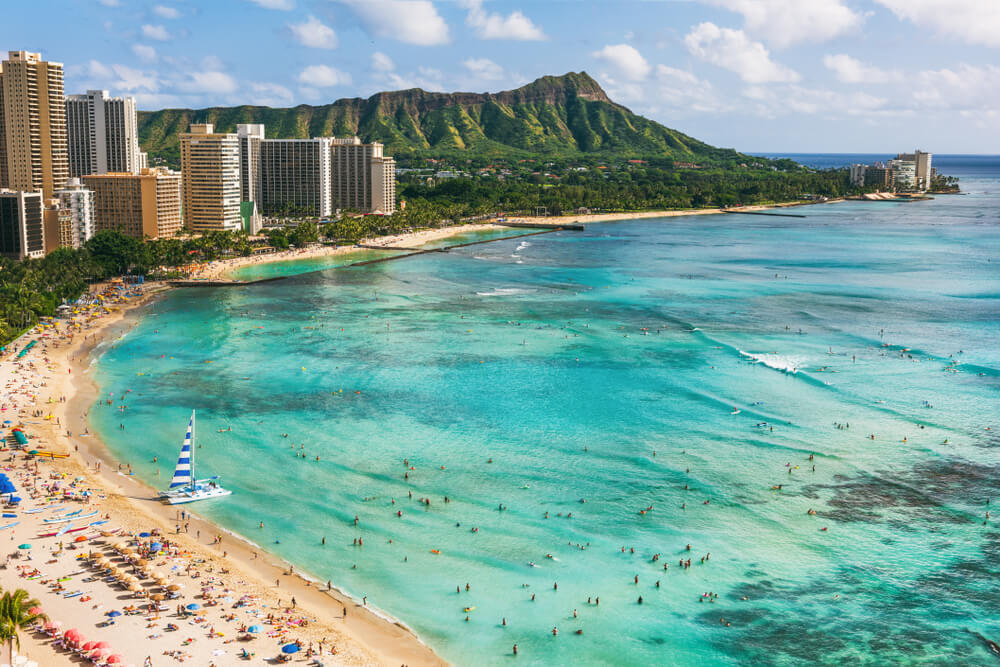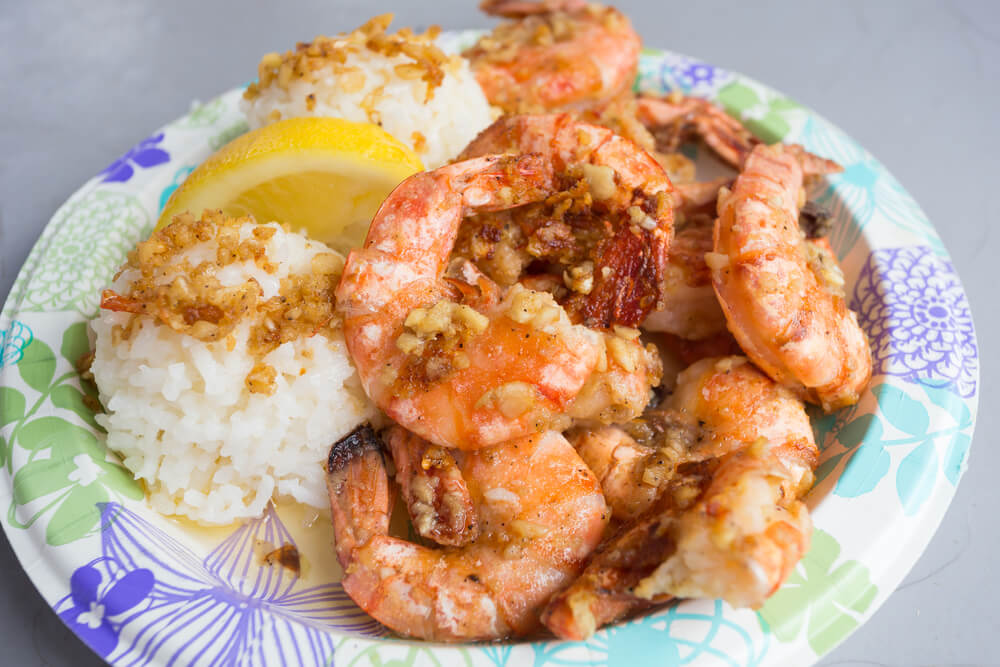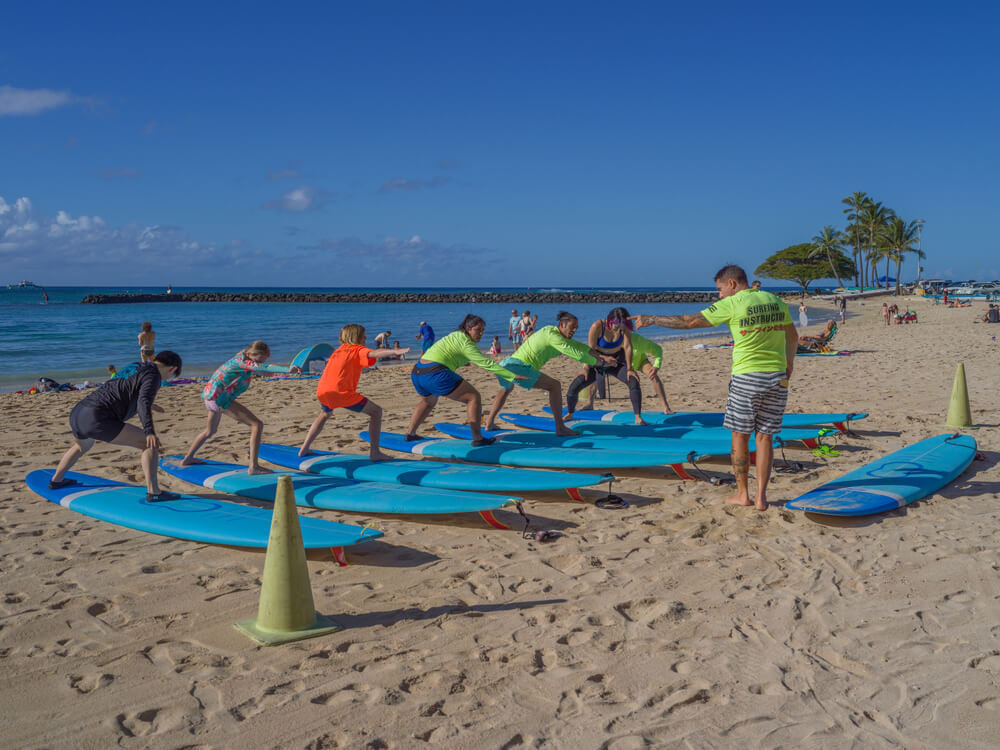There is no denying, a trip to Hawaii can be very expensive. As a long-time top-tier travel destination, there are decades-old models in place for hotels, resorts, restaurants, airlines, and rental car companies to help you give up your money as part of your vacation. Fortunately, there are plenty of ways to save, and the below list of tips to save money in Hawaii will help ensure your trip costs don’t exceed your budget.
From the moment you book your flights and accommodation to the time to time you land on the ground, and up until you set foot on the plane to return home, there are simple tips to help you make money-saving decisions along the way.
Wander and Experience is reader-supported. When you buy through links on our site, we may earn an affiliate commission.

1. Visit Oahu
Start saving money on your Hawaii vacation by planning your visit to the most budget-friendly island in the state. The top tip to save money in Hawaii for a reason, Oahu offers the broadest range of accommodation options and the most affordable hotels, the largest rental car fleet and best prices, and a wide range of stores and restaurants catering to residents.
You can find ways to save on Oahu in nearly every facet of your trip plan, and you won’t be missing out on anything. Oahu offers some of the state’s best beaches and natural scenery but benefits from having the state’s largest population of residents, which creates a market for more local businesses that don’t survive off of tourists and charge tourist prices.
2. Book a Condo Instead of a Hotel Rooms
Hotel rooms can be expensive in Hawaii, and multiple hotel rooms for a family can make a trip to Hawaii unrealistic for many budgets. However, with an abundance of condo rentals available across islands, vacation rentals can provide enormous savings for groups that need multiple beds or multiple bedrooms.
The added benefit of booking a condo instead of a hotel is the additional savings from having a kitchen for cheaper meals compared to hotels
3.Cook Your Own Meals
As mentioned in the last tip, though worth emphasizing on its own, if you have a kitchen in your vacation rental, you can avoid the need to eat all of your meals out. Instead, you can save your food budget for the more memorable or authentic local meals by cooking at your rental. This method is beneficial for preparing food to take with you to the beach or hike, where heading to a restaurant may slow down your plan for the day
4. Shop at Grocery Stores Away From Waikiki or the Resorts
Whether you are cooking at your rental or need snacks or drinks to supplement your trip, making a stop at Safeway, Costco, Target, or Walmart, will help reduce your trip costs. Avoid the
5. Look Out For Resort Fees and Parking Fees
Beyond the room rate for hotels or resorts, many hotels will charge a resort or amenity fee. These fees typically range from $30 to $40 and are charged per night per room. Across a week, the fees add up, with a 7-night stay coming in at $210-280 total in resort fees. This makes this one of the most important tips to save money in Hawaii.
What do you get for these fees? Not much. Each hotel will include a list of benefits, typically things that would either be free or unwanted during a stay. Free Wifi, gym access, and beach or pool towels are commonly listed. Some hotels even go so far as to list out free in-room coffee and tea, slippers, and free local and 1-800 Number calls.
There may be a few items of interest, like ukulele or hula lessons or lei making. However, these classes can fill up and require reservations.
In addition to the resort fees, larger hotels and resorts will often charge parking fees. This is the same for resorts across all islands. These parking fees can range from $20-40 per 24-hour period.
While there are ways to avoid parking fees, more on that below, there aren’t ways to avoid resort fees other than booking hotels that don’t charge them. The critical consideration is to be aware of these fees when booking your hotel. Comparing two $300 a night properties makes for easier decision making if you know that one charges a $40 resort fee and a $40 parking fee and the other doesn’t, making the actual cost comparison $300 vs. $380 a night.
6. Shop Around for Your Car Rental
Car rentals in Hawaii can range from standard pricing to outrageously expensive. Due to the isolated island locations, supply is limited, and demand can skyrocket. If you decide that having a car for your vacation is essential, shop around for the best rate.
Ensure you exhaust any discounts you might have access to, whether through your company or other organizations you are a member of. Otherwise, book through Discount Hawaii Car Rental. Which generally offers the best rates through the major rental car companies and requires no prepayment and free cancellation, making it a no-risk booking.
7. Consider Daily Car Rentals in Waikiki or From Resorts
If you plan on staying in Waikiki or at a major resort area across the islands, consider booking single-day rental cars only when you plan to explore the island. With rental car locations throughout Waikiki and at resorts on the major islands, you can rent a car for the day, return in the evening, and avoid the $30-40 parking fees at the same hotels and resorts.
Be aware of the rental agency’s hours, as daily car rentals work well for daytime exploring, though some branches will close at 4 pm or 5 pm, limiting your ability to have dinner away from the resort.
Consider booking a one-way car rental from Honolulu Airport to Waikiki for your first day or two; this allows you to save additional money on the taxi from the airport and doesn’t commit you to pay for a car during your whole stay in Waikiki
8. Avoid the Peak Periods
Hawaii’s peak season from a price perspective lasts from mid-December to mid-March, with Christmas week seeing sky-high prices. July and August also see spikes in prices, with many families visiting over summer vacation.
There is no complete off-season where prices significantly drop, though if you book in May to June or September to November, you will be able to find slightly better deals max more availability.
9. Book Your Trip in Advance
If you have locked in your travel dates, don’t hesitate to book, as prices will generally rise as it gets closer to the travel time. In addition, airfares, room rates, and rental cars will all go up in price as the supply reduces, making it better to book ahead and avoid late price surges from spikes in demand.

10. Fly Southwest Inter-Island to Save Baggage Fees
The two largest carriers for inter-island flights are Hawaiian Airlines and Southwest Airlines; both offer similarly priced fares between islands, with the cheapest fares currently in the $80 to $90 range for a one-way economy ticket.
The critical difference is that Hawaiian charges $25 for your first checked bag and $35 for the second checked bag, while Southwest allows two free checked bags per passenger. There is also no difference in comfort for the flights that take less than an hour between any two airports in Hawaii.
11. Book an Open-Jaw Itinerary
If you plan to visit more than one island on your trip, consider booking an open-jaw flight itinerary, which is an itinerary where you arrive and depart from different cities.
Rather than searching for round-trip flights to Honolulu and then having a separate round-trip between islands, use the multi-city search feature in Google Flights or your preferred flight search to search itineraries with different arrival and departure cities. This search will then allow you to book a separate one-way ticket between islands on Southwest, providing you with the cheapest possible itinerary.
12. Fly on a Cheaper Date
If you are flexible with your travel dates, use Google Flight Search to find the cheapest dates and times to fly across multiple days, weeks, or months to maximize your savings. More inexpensive flight dates typically align with cheaper hotels and rental cars as these are all based on the same visitor number, helping you find the most affordable dates for your trip.
13. Use Points and Miles
With consistently high room rates at resorts and plenty of flights to and from the islands on the major carriers, Hawaii offers plenty of great redemption opportunities to those holding large mile or point balances.
Those with flexible dates can find that saver awards are available that offer lower point or mile requirements for redemption, providing additional value with your award booking. In addition, Hilton and Hyatt waive the resort fees for hotel award booking, further extending your savings with those programs.

14. Eat Away From Waikiki and the Resorts
Hotel and resort restaurants and those closely around them will often charge the highest prices and won’t always provide the best food. Generally, the resorts and restaurants around Waikiki are charging prices to compensate for their expensive real estate footprints, with cheaper restaurants found away from these areas with more reasonable menu prices.
This tip is not to say that having that sunset cocktail in Waikiki is not worth it; it suggests that you go into it considering you are paying primarily for the view and the atmosphere.

15. Embrace Shopping Centers and Food Trucks for the Best Food
The best local food in Hawaii can be found in nondescript shopping centers, cottage-style restaurants, and food trucks dotting the islands. These are the places where locals eat, and most are limited in their decor or the surrounding environment but win their customers based on their food.
These restaurants offer the best value for those looking to eat the best local food, with plenty of meals that will cost $10-15 on offer, which would cost closer to $30-50 in a resort for a similar meal, though likely less authentic.
16. Bring Your Beach Essentials
While the Hawaiian Islands have plenty of beach gear for sale or rent, you’ll likely find higher prices and less selection than what you can find at home or online. So come prepared with everything you need to avoid paying exorbitant prices for that beach towel that you forgot you would need.
Don’t waste money on beach canopies or snorkel set rentals if you can get your money’s worth with multiple uses. If you really need to pick something up on your trip, head to Walmart or Target and stay away from Waikiki or your hotel.
17. Decide on Which Activity You Truly Want to Do
It is effortless to blow through your trip budget on activities across a week’s vacation if you aren’t paying attention to your spending. For example, a luau can cost $200 a person, with a whale watching tour coming in at $100 a person, surf lessons at $200 for 90 minutes, $150 for a round of golf, and a helicopter volcano tour at $250.
The above highlights a few of the high-ticket items, but the list goes on. Decide on the can’t miss activities for your trip and your budget and skip the rest. Hawaii has plenty to offer in terms of scenery and beaches, so you don’t need to spend a fortune to get the most from it.

18. Skip The Luau
Many visitors approach a visit to a Hawaiian luau as a need-to-try-once activity that is essential to their vacation. However, while luaus may be a great way to experience the local culture and heritage of native Hawaiians, this comes with a price, typically $150-$200 per person.
There is no denying that the music, dance, fire shows, and traditional dress is a stunning display of the local culture. Still, there are a couple of alternatives to those who are lukewarm to the idea of paying that much for a meal with a dance performance.
For a complete cultural experience, including the best show in Hawaii, along with a rewarding tour of traditional Polynesian villages, the Polynesian Cultural Center on Oahu offers tickets to a show that includes access to tour their full center and learn about the islander’s fascinating history. While these tickets aren’t cheap, they offer a better show and several hours of entertainment at their Northeast Oahu complex.
Those looking for a free option can check out a free hula show at your resort, with most larger resorts offering brief shows daily. Those in Waikiki can visit the Kuhio Beach Hula Show, which is held three days a week.
19. Buy a Go Card for Significant Savings on Oahu
Those who can pack a lot into their days will find significant savings buying a Go Card for sightseeing on Oahu. The packages include free admission to several attractions, as well as a premium attraction like a luau, sunset cruise, or surf lessons when buying a 3-day pass.
Passes are available in 1 to 7-day options and include over 40 attractions on Oahu, from private museums at Pearl Harbor to tours of the Iolani Palace and island farms. While they won’t fit every visitor’s needs, those who can get enough use from them will save a lot.
20. Look for Discount Books or Magazines
Around shops and tourist attractions across the islands, you’ll often see a rack with free coupon books or magazines. Yes, this marketing approach is still going strong, and grabbing one of these books for a browse on the beach can often uncover a coupon or discount for an activity you already had planned.
21. Sign Up for the Entertainment App
The same company that used to make those thick coupon books that used to be sold at school fundraisers with buy-one-get-one coupons now offers the book in a digital form for a subscription of as little as $2.99 a month.
With coupons for restaurants, attractions, buy-one-get-one golf fees, additional discounts for car rentals, and hotels, the app quickly pays for itself with a single-use a month or an annual subscription for those who will get use from it.
22. The Best Activities Are Free
It’s easy to get carried away with all that Hawaii has to offer. But, while TV and the movies might lead prospective visitors to believe that a luau, surf lesson, and helicopter tour are essentials of a trip, the real attraction is the beauty of the state’s landscape, beaches, and waters.
Take in the natural scenery, hike through Hawaii’s lush forests, swim and snorkel in the clear waters, and enjoy the temperate weather. Start your trip plan by enjoying the environment and adding activities based on your budget, but know that you don’t need to spend a dollar on any attractions to still have an incredible vacation in Hawaii.

23. Google Surf/Kayak/Paddleboard Rentals or Lessons Ahead of Time
A simple search can find that a surfboard rental can be as cheap as $20 a day vs. $50 a couple of hours through a hotel or resort. The same goes for kayaks and stand-up paddleboards and the lessons for each. Depending on where you are staying, do a search for the rental gear or lessons from private companies nearby, as you will likely find a much cheaper option and often better equipment by going with a private shop.
24. Prebook a Taxi in Honolulu
If you are staying in Oahu and don’t plan on renting a car on arrival, consider prebooking a taxi. With Uber and Lyft offering cheaper rates (as low as $23 to Waikiki) than metered taxis ($35-50 to Waikiki), the risk of relying on those services is that at busier times, their prices can reach as high as $75 one-way to Waikiki.
By booking a taxi before arrival, you can lock in at a fixed rate, with services offering as low as $29 to Waikiki. Check out Charley’s Taxi to book a taxi before your arrival. Consider this for the same savings on your departure as well.
25. Visit Swap Meets For Souvenirs
Avoid the overpriced gift shops and find a more exciting selection of souvenirs or gifts at a swap meet on any island. Swap meets are like flea markets, with a wide range of local products, homemade goods, craftworks, and vintage items on offer. The largest in the state is the Aloha Swap Meet on Oahu, which operates three days a week, though all islands run their own versions.













